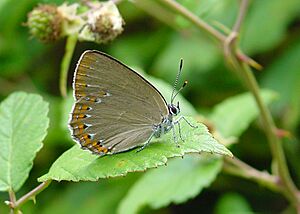Laeosopis facts for kids
Quick facts for kids Laeosopis |
|
|---|---|
 |
|
| Conservation status | |
| Scientific classification | |
| Kingdom: | |
| Phylum: | |
| Class: | |
| Order: | |
| Family: | |
| Genus: |
Laeosopis
Rambur, 1858
|
| Species: |
L. roboris
|
| Binomial name | |
| Laeosopis roboris Esper, 1789
|
|
The Spanish purple hairstreak (Laeosopis roboris) is a beautiful butterfly found in parts of Europe. It belongs to the Lycaenidae family, which includes many "blue" and "copper" butterflies. This butterfly is the only species in its group, called a monotypic genus, which makes it quite special! You can find it flying in the Iberian Peninsula (that's Spain and Portugal) and in south-eastern France.
Contents
Appearance of the Spanish Purple Hairstreak
This small butterfly has a wingspan of about 12 to 15 millimeters. That's roughly the size of your thumbnail!
What the Wings Look Like
The top side of the Spanish purple hairstreak's wings is mostly black. Male butterflies have shiny blue scales near the base of their wings, spreading out towards the edges. Females usually have this blue color only closer to their body.
The underside of the wings is a soft, ash-grey color. It has a yellow border with light blue spots. Just inside this border, you might see some black dots with pale edges.
Where it Lives
This butterfly is mostly found in southern France, especially near the Pyrenees mountains, and across Spain. A special form from Portugal, called lusitanica, has a brighter yellow underside and a wider yellowish-red band on its forewings.
Life Cycle of the Butterfly
Like all butterflies, the Spanish purple hairstreak goes through several stages: egg, larva (caterpillar), pupa, and adult butterfly.
The Egg and Larva
The eggs of this butterfly are round and reddish. The larvae, or caterpillars, look a bit like woodlice. They are grey with short black bristles. They have two dark yellow lines along their back, which are broken up. There's also a black spot right behind their head. The underside of the caterpillar is a dull yellow, and its legs are yellow too. These caterpillars are a bit slow, but they eat quickly!
The Pupa
After the caterpillar stage, it turns into a pupa. This pupa is shaped like a barrel and is attached to a surface with several threads.
Adult Butterfly Flight Season
Adult Spanish purple hairstreak butterflies usually fly from June until autumn. However, in some warmer areas, they can be seen as early as April and as late as October. They like to live in valleys where there are lots of trees and bushes. You can often find them resting on ash or chestnut trees. If you disturb them, they often fly back to the same spot, which makes them easier to observe!
Different Types of Spanish Purple Hairstreaks
Within the main species, there are several different groups called subspecies. These are slightly different forms of the butterfly that live in specific areas. Here are some of them:
- L. r. escorialensis (found in Spain)
- L. r. lusitanica (found in Portugal)
- L. r. demissa (found in Italy)
- L. r. higginsi (found in Granada, Spain)
- L. r. magis (found in north-western Spain)
- L. r. mudarra (found in north-eastern Spain)
- L. r. portaensis (found in the eastern Pyrenees)
- L. r. thiersi (found in southern France)
What the Caterpillars Eat
The caterpillars of the Spanish purple hairstreak mainly eat the leaves of ash trees, especially the common ash tree (Fraxinus excelsior). They might also eat other types of ash trees and possibly privet plants (Ligustrum vulgare).


